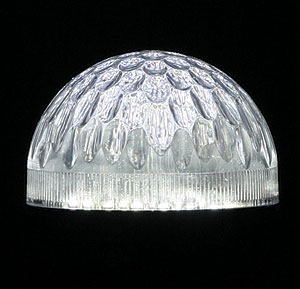What's the Difference: Green lightbulbs
Compact fluorescents and light-emitting diodes are energy-efficient alternatives to standard bulbs
The incandescent lightbulb is one of the most inefficient items in your home. Roughly 90% of its energy from electricity is converted into heat, and only the remaining 10% results in actual light. Incandescent bulbs waste resources and money. Compact fluorescent lightbulbs (CFLs) and light-emitting diode (LED) bulbs are more-efficient alternatives. However, each bulb has characteristics worth knowing about before being put to use.
Compact fluorescents create ambient light

Much like incandescent bulbs, CFL bulbs cast light in all directions, which makes them useful in similar applications. With a color-rendering index of 85 and a color temperature of around 3000°K, they produce a similar-looking light. (For more on color-rendering index and color temperature, read the “Q&A,” Can compact fluorescents emit warm light?).
CFLs perform best providing indoor area lighting, especially in lights that regularly stay on for extended periods. Frequent on/off cycling can reduce the bulb’s life span as can extremely high outdoor temperatures. Very low temperatures can decrease a CFL’s light output. CFL bulbs have one major point of concern. They contain a small amount of mercury. Harmless when the bulb is intact, the mercury poses health and environmental problems if the bulb is broken. Because of the mercury content, CFLs should be disposed of at a hazardous-waste collection site instead of being thrown out.
CFL Specifications
| Type: | Compact fluorescent (CFL) |
| Efficacy: | 58 to 110 lumens/watt |
| Operating life: | 10,000 to 12,000 hours |
| Dimmable: | Certain models |
| Disposability: | Hazardous household waste |
|
Color-rendering index: |
82 to 85 |
|
Correlated color temperature: |
2700°K, 3000°K, 3500°K, 4100°K |
| Best use: | Recessed and open-light sources that stay on for more than 15 minutes at a time |
| Cost: | $5 |
| Worth mentioning: | To find a location to dispose of CFL bulbs, visit www.lamprecycle.org or www.earth911.org. |
Light-emitting diode bulbs are directional

White-light LED bulbs produce around 25 to 30 lumens per watt, which is more efficient than an incandescent but not as efficient as a CFL. LEDs last much longer, though: up to 10 years, according to some manufacturers.
LED bulbs cast light only in the direction in which their diodes are pointed, which makes them great for task and accent lighting, but not for area lighting. Also, they don’t have a filament that can be broken, so they are more durable than other bulbs. Similar to CFLs, an LED bulb’s life span can be diminished by extreme outdoor temperatures.
The most noticeable difference with LED bulbs is the quality of their light. LED bulbs have a high color temperature and a poor color-rendering index. Currently, most lighting experts agree that CFLs are the best-performing green lighting option. But with LED technology advancing at a fast pace, it’s worth keeping an eye out for more-refined LED products.
LED Specifications
| Type: | Light-emitting diode (LED) |
| Efficacy: | 25 to 30 lumens/watt |
| Operating life: | 60,000 to 100,000 hours |
| Dimmable: | Yes |
| Disposability: | General refuse |
|
Color-rendering index: |
72 to 75 |
|
Correlated color temperature: |
4000°K, 5000°K |
| Best use: | Task and accent lighting |
| Cost: | $45 |
| Worth mentioning: |
Rather than burn out, LEDs decrease in brightness over time. This process can gradually alter the aesthetic of the |
Photos by: Krysta S. Doerfler and Rob Yagid
Fine Homebuilding Recommended Products
Fine Homebuilding receives a commission for items purchased through links on this site, including Amazon Associates and other affiliate advertising programs.

Get Your House Right: Architectural Elements to Use & Avoid

Not So Big House

Code Check 10th Edition: An Illustrated Guide to Building a Safe House


























